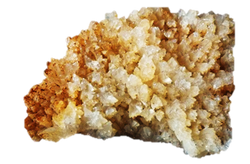The Ardennes

INTRODUCTION TO ARDENNES GEOLOGY

Located next to reception, this room is an introduction to a journey into the geological history of the Ardennes.
A section crossing the department from North to South allows you to visualize the geological levels encountered and to become familiar with the different types of rocks that can be discovered in the Ardennes subsoil.
Furthermore, an exhibition on this typical rock that is slate, its main deposits and the work relating to its extraction and development is presented in this same room.
ARDENNES MINERALOGY ROOM

The Ardennes and, in particular the primary massif, contain mineralspresenting a beautiful diversity and crystallizations worthy of interest.
In a central display case, you can admire magnificent quartz crystalsof great purity discovered in the Meuse valley.
They rub shoulders with numerous specimens of Fluorite with various colors coming from old mines at Pointe de Givet, now abandoned.
Samples of iron pyrite (locally called “Fool’s Gold”) ")coming from old slate quarries arediscover.
Other showcases display rare gypsum crystallizations reminiscent of sand roses but also specimens of calcite, marcasite and pink dolomite.
 |  |  |  |
|---|---|---|---|
 |  |
THE HALL OF NATIONAL NATURAL RESERVES

This room is dedicated to the Vireux-Molhain National Nature Reserve and the Pointe de Givet National Nature Reserve, divided into various sites.
Numerous explanatory panels show the geological, faunal and floristic diversity of this region.
For the Vireux-Molhain paleontological reserve known as “the customs wall”, the interest lies in the exceptional fossil richness of this deposit dating from the primary era (Paleozoic) of Devonian age and more precisely from the Lower Eifelian part. average of the Devonian.

.jpg)
The organisms that lived there were mainly trilobites (arthropods close relatives of crustaceans and now extinct), brachiopods, molluscs, crinoids, annelids and cnidarians.
All these fossils are displayed in the room's display cases and described on numerous panels.
The fossils that were discovered and studied there by Denise Brice of the Faculty of Lille for brachiopods and by Bernard Gibout of the Mineralogical and Paleontological Association of Bogny-sur-Meuse for trilobites testify to a marine environment in shallow seas. where fine terrigenous sediments have accumulated.

ARDENNES PALEONTOLOGY ROOM

This room entirely dedicated to paleontology allows you to go back in time and presents the geological history of the department starting from the primary era and ending with the presence of man.
The different periods and geological stages follow one another throughout the showcases and allow us to reconstruct the evolution of life on our territory.
A multitude of fossils of all species are gathered here with specimens remarkable both for their rarity and for their often exceptional state of conservation.
Note very beautiful ammonites, sometimes large, sea urchins of various ages, witnesses of warm seas which covered the Ardennes, but also a vertebra of a herbivorous dinosaur unique in France: a Cetiosaurus which was the size of a Diplodocus. Mammoth bones and a skull cap from an Iron Age man round off the visit.
Cetiosaurus vertebra fragment


